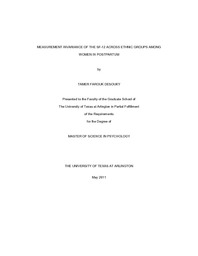
ATTENTION: The works hosted here are being migrated to a new repository that will consolidate resources, improve discoverability, and better show UTA's research impact on the global community. We will update authors as the migration progresses. Please see MavMatrix for more information.
Show simple item record
| dc.contributor.author | Desouky, Tamer Farouk | en_US |
| dc.date.accessioned | 2011-07-14T20:54:16Z | |
| dc.date.available | 2011-07-14T20:54:16Z | |
| dc.date.issued | 2011-07-14 | |
| dc.date.submitted | January 2011 | en_US |
| dc.identifier.other | DISS-11077 | en_US |
| dc.identifier.uri | http://hdl.handle.net/10106/5857 | |
| dc.description.abstract | Purpose: The purpose of this study was to examine differential item functioning (DIF) as a plausible cause of subgroup variation in the short-form health survey (SF-12). Methods: Cross sectional secondary data analysis of postpartum women (n = 655) who participated in a prospective cohort longitudinal design was conducted. Hypotheses predicted that subgroups would exhibit DIF among items measuring physical health as assessed by the SF-12. If DIF is found then other postpartum related variables, such as social support and parity, will explain DIF through mediation analysis. A Multiple Indicator Multiple Cause (MIMIC) model was used to examine DIF among these subgroups of women. Results: Items SF1 "self assessed general health", SF8 "bodily pain", and SF9 "calm and peaceful" all indicated DIF. However, only DIF effects of African-Americans endorsing SF8 (OR = 2.11, CI95 = 1.20, 3.71) and Hispanics endorsing SF9 (OR = 2.62, CI95 = 1.64, 4.17) signified meaningful effect sizes as indicated by the Odds-Ratio values. Further examination of the SF1 "self assessed general health" and SF8 "bodily pain" DIF effects, relevant to the hypotheses of this study, was conducted in order to explain the DIF effect. The DIF effect of Hispanics endorsing item SF1 "self assessed general health" more than Caucasians explained only 47% of the total effect present, while on the other hand, the DIF effect for African-Americans endorsing the SF1 item explained 21% of the variance in the total effect. Supplementary assessment using social support as a mediator in the SF1 "self assessed general health" DIF effect revealed a significant relationship. Specifically, social support partially mediated the DIF effect for both ethnicities. Thus, social support explained the differential response of both of these ethnicities to this specific item. The SF8 "bodily pain" item had a meaningful DIF effect, and for Hispanics explained 32% while for African-Americans accounted for 50% of the variance in the total effect. Employing both social support and parity as mediators yielded a significant relationship. Both mediators partially mediated the DIF effect for African-Americans but only social support partially mediated the DIF effect for Hispanics. Conclusion: The results of this study reveal items SF8 "bodily pain" and SF9 "calm and peaceful" as biased towards Hispanics and African-Americans, respectively, after matching on overall mental or physical health, compared to Caucasian women. However, utilizing mediation analysis explained the DIF effects and provided more understanding of the bias towards these ethnicities. Implications of this study are to use more than one method to assess DIF and to use psychological theory to explain the DIF effects through mediation analysis. | en_US |
| dc.description.sponsorship | Mora, Pablo | en_US |
| dc.language.iso | en | en_US |
| dc.publisher | Psychology | en_US |
| dc.title | Measurement Invariance Of The SF-12 Across Ethnic Groups Among Women In Postpartum | en_US |
| dc.type | M.S. | en_US |
| dc.contributor.committeeChair | Mora, Pablo | en_US |
| dc.degree.department | Psychology | en_US |
| dc.degree.discipline | Psychology | en_US |
| dc.degree.grantor | University of Texas at Arlington | en_US |
| dc.degree.level | masters | en_US |
| dc.degree.name | M.S. | en_US |
Files in this item
- Name:
- Desouky_uta_2502M_11077.pdf
- Size:
- 806.9Kb
- Format:
- PDF
This item appears in the following Collection(s)
Show simple item record


